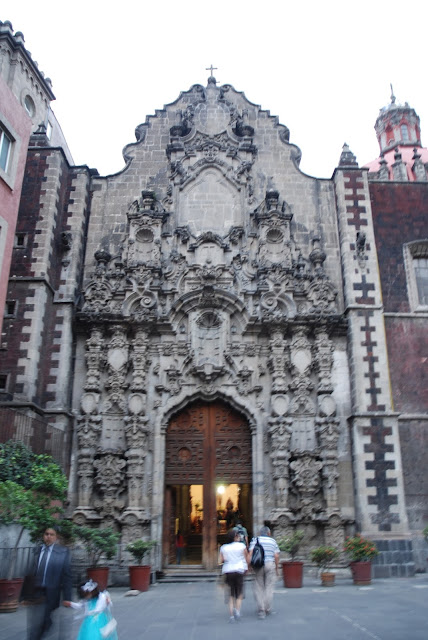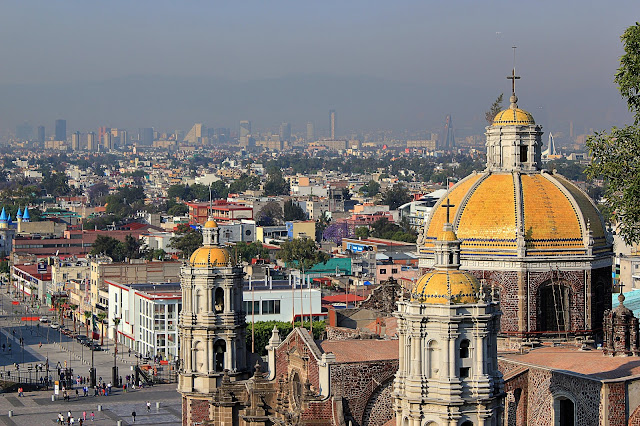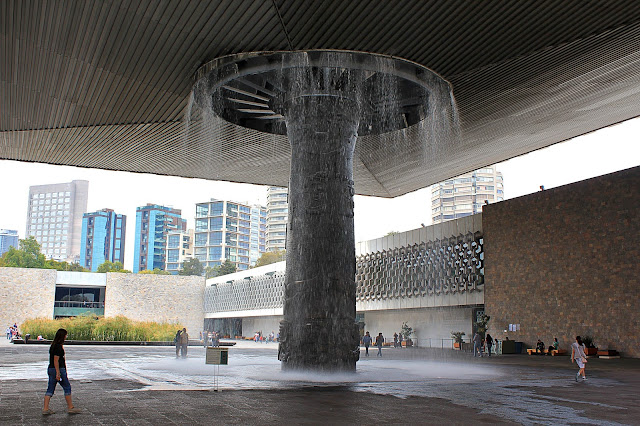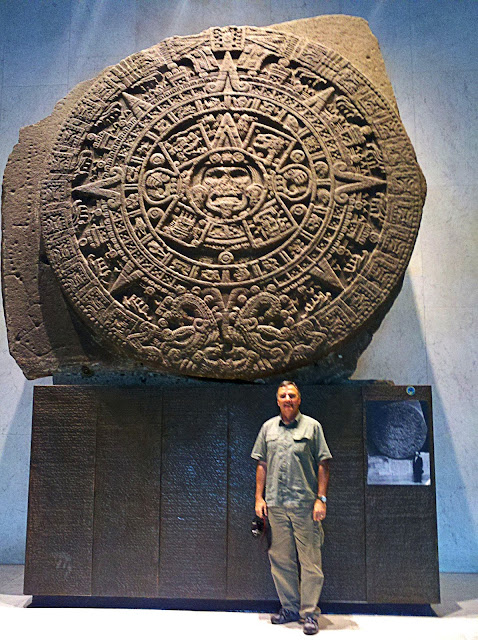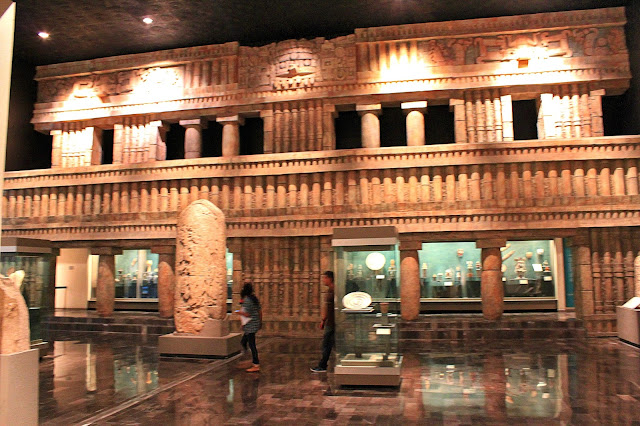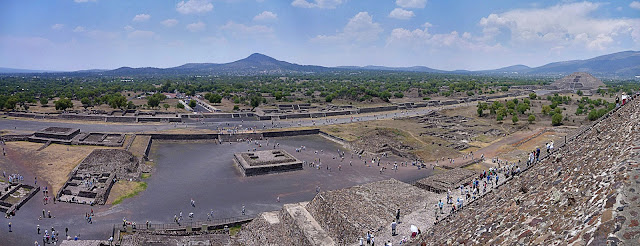Mexico City
Mexico City
A Geologic Perspective
See what happens when you build a city on a lake and pump out the water!In addition to fabulous historical, cultural, architectural, and art attractions, Mexico City is a geologic attraction as well because it was built on a lake, and has suffered the consequences for 700 years.
(Above) The Templo Expiatorio A Cristo Rey, built 1695-1709, has subsided, tilted, and shifted southward on the old lake-bottom muds. It was closed for many years and the Basilica de Nuestra Senora de Guadalupe (on the left) was built in the 1970's. The Templo has since been reinforced with steel and cables and reopened to the public.
Visiting Mexico City
I can't say enough about how impressive my first visit to Mexico City was! There is so much to see! We went there to study the subsidence, but became captivated by its beauty and rich history. The Museo Nacional de Antropologia alone will keep you busy for a couple of days, and the Aztek sites like Templo Major in the central city and the much older city of Teotihuacan north of the city are worth the entire trip by themselves. Then there are Palacio Bellas Artes, Museo Nacional de Arte, and other art museums that stack up to anything you'll find anywhere, fabulous architecture, and of course there's the food.Travel Mexico City
Air Travel: The international airport is well-served by major carriers, and it's very easy to catch a taxi or shuttle from there to your hotel.Lodging: Like any major city, good lodging options are innumerable. We stayed downtown at the Hotel Catedral and enjoyed it very much. Their restaurant kept us happy (and healthy!) for days, and it is close to the downtown sites (Templo Mayor, Avenida 16 de Septiembre, Bellas Artes, etc.).
Vehicle: Use taxis and buses to preserve your driving sanity. It's very easy to get lost in Mexico City, and the public transportation system goes everywhere, including Teotihuacan.
Considerations: If you stick with reputable restaurants and avoid street food, you should stay healthy. Of all the countries I've traveled in, Mexico is the only one that made me sick, but that was my fault for not resisting the temptation of a 4-meat hot torta from a street vendor. Oh, and street chalupas. Carry bottled water with you everywhere you go.
When on foot, stay in the tourist areas and you should be safe. Be alert for pick-pockets (the only place I've encountered one was on a bus in Rome). Follow the advice of reputable travel sites.
Keep in mind that Mexico City is at an elevation of 7300 feet! Simple walks may tire some people. The best way to cope is to consciously breathe more deeply than you would normally.
(Above) Interactive Google Map of central Mexico City.
Geology of Mexico City
Mexico City was built on Lake Texcoco. The Azteks dumped dirt into the lake to create fortress-islands they called Tenochtitlan in the 1300's. The new city expanded island by island, and was originally criss-crossed with canals like Venice, Italy.(Above) A model of Tenochtitlan showing it as a city of canals.
The Mexico people of Tenochtitlan were captured by Cortez in 1521, beginning a new era of expansion and construction, often on top of Aztek structures. Lake Texcoco was slowly drained beginning in the 1600's, and after the lake was no more, groundwater became in increasingly important resource. Depletion of underground aquifers caused further subsidence of the already soft lake sediments beneath the city. Today, evidence of subsidence and uneven settling are abundant all over the city.
(Above) Mexico City was built outward from the site of Tenochtitlan in Lake Texcoco. Areas that are on the former lake have experienced the most severe subsidence and uneven settling.
(Above) Old central Mexico City, the former Tenochtitlan, suffers from the most severe subsidence and settling.
(Above) This mural in the National Archaeological Museum shows Tenochtitlan within Lake Texcoco.
(Above) View of the National Cathedral from Hotel Catedral in the central city.
(Above) Catedral Metropolitana de la Ciudad de México was begun in 1573 atop older Aztek structures surrounding the Templo Mayor. Subsidence damaged the structure over the years, but the building was stabilized in the 1990's and is considered no longer threatened. It is on the north side of the Plaza de la Constitucion in downtown Mexico City.
(Above) Even the entrance to the Templo Mayor shows how badly buildings have settled.
(Above) The museum at Templo Mayor contains a huge and fantastic array of Aztek and other pre-Spanish artifacts. I was amazed by the artistry on display, like the face on this vase.
(Above) What was once a horizontal plaza in Templo Mayor is now dramatically tilted. You can see how rock was used to firm up the ground on the right.
(Above) Even original paint is preserved in many places in Templo Mayor. Reconstructions and models show us how very colorful the old Aztek cities were. Mexico still is today!
(Above) The Templo Mayor excavation with the Metropolitan Cathedral in the background. Notice how tilted the Aztek structures have become.
(Above) The Spanish used pilings driven into the mud to attempt to stabilize their structures, much like has been done in Venice and New Orleans. Their pilings often penetrated and damaged the Aztek structures beneath them, and were not strong enough to keep the buildings level.
(Above) In the downtown area, nearly every street shows signs of subsidence, like these crooked buildings.
(Above) Most of the streets on old Tenochtitlan have settled and are wavy like this one. Notice the hump near the white car.
(Above) Severely tilted walls of an old church in the central city. Note the lightpole for a vertical reference.
(Above) Iglesia de San Francisco is the third church built on this site because the first two sank into the swamp (a scene from "Monty Python and the Holy Grail" comes to mind!). It's on Av. Madero near the Bellas Artes.
(Above) Inside the Iglesia de San Francisco, you can see how the chandeliers are hanging off-center because of the building's tilt.
(Above) Nuestra Señora de Loreto (Our Lady of Loreto) Church was built from 1806 to 1819. Because more dense stone was used on the east (right) side, the church developed a strong tilt almost immediately. After a few decades it was apparent the tilting had ceased, and the church has been used continuously ever since.
(Above) Another wavy street in the central city. Resist the hot dogs!
(Above) A view of Mexico City southward over the Templo Expiatorio A Cristo Rey and Basilica of Our Lady of Guadalupe (with the turquoise roof). This is one of the "must-see" sights when you visit Mexico City.
(Above) Interactive Google Map of the Templo and Basilica de Guadalupe. These are accessible by bus or taxi from downtown.
(Above) These amazing stairs lead up to the overview above.
(Above) As dicussed above, the Templo Expiatorio A Cristo Rey, built 1695-1709, has subsided, tilted, and shifted southward on the old lake-bottom muds. It was closed for many years and the Basilica de Nuestra Senora de Guadalupe was built in the 1970's. The Templo has since been reinforced with steel and cables and reopened to the public. You can see here how it tilted and slid toward the right, which was toward the lake.
(Above) When you stand against the walls of the Templo, the bell towers hang over your head!
(Above) The interior of the Templo is gorgeous. The marble columns at the altar are from Scotland. The building was reinforced with steel straps (visible on the pillars) and other structural elements.
(Above) The Templo del Pocito next to the Templo complex has subsided nearly 2 feet below the surrounding area just in modern decades.
(Above) The Palacio de Bellas Artes houses an opera house and architectural museum. It is absolutely breath-taking!
Amazing Mexico Anthropological Museum
(Above) The Museo Nacional de Antropología is one of Mexico City's major attractions. Its collections of pre-colonial structures, art, and artifacts are truly world-class.
(Above) The Umbrella structure and fountain at the museum entrance is magnificent in person, and sets an appropriate stage for the amazing things you'll see inside.
(Above) Interactive Google Map to the museum.
(Above) The Aztek "Sun Stone" was buried by the Azteks shortly after the Spanish invasion, and rediscovered in 1790 during repairs to the Metropolitan Cathedral at Templo Mayor. The central figure is the Sun god, and hence the name. Some have interpreted this famous stone as an Aztek calendar, but the museum's anthropologists now believe it was a ceremonial basin or altar on which gladiators were sacrificed. It is made of basalt (dark lava rock) and weighs 24 tons.
(Above) Who's got a big head? This is a relatively small Omec head from southern Mexico that dates to between 1500 and 400 B.C. Very little is known about the Olmecs, but modern residents of the area still have facial features similar to those on the giant carvings.
(Above) The museum contains whole sections of Aztek buildings, a truly remarkable feat of preservation and engineering.
(Above) A decorative gold plate.
(Above) An interesting carved stone box.
Mexico City
(Above) Mexico City has an unparalleled juxtaposition of ancient and modern. Note the tilt of the colonial-era structure in the foreground.
(Above) You'll be delighted with Mexico City's modern, creative, and sometimes whimsical architecture.
(Above) Everywhere you look, you see evidence of Mexico City's geological legacy. These two buildings across the street from Palacio de Bellas Artes have separated because of subsidence.
Teotihuacan
I can't leave you without a quick look at Teotihuacan! It is only about 30 miles northeast of Mexico City, and is accessible by buses and shuttles.
Teotihuacan was built from about 100 B.C. to around 500 A.D. (by whom? Perhaps the Maya or contemporaries), and at its peak was the 6th largest city in the world with a population estimated at 125,000. It may have continued as a large population center until the 7th or 8th centuries. The large pyramids are obvious archaeological wonders, but the city is also renowned for its preserved murals, multi-family housing units, numerous important artifacts, and its shear size. It is a UNESCO World Heritage site, and covers more than 32 square miles. Less than 5% has been excavated.
(Above) Interactive Google Map to Teotihuacan.
If you go during hot months, take sunscreen, a hat, and lots of water!
(Above) A view down the Avenue of the Dead from the Pyramid of the Moon. Pyramid of the Sun is at the left.
(Above) A view of the Pyramid of the Moon from atop the Pyramid of the Sun. Notice that many structures in the foreground have not yet been excavated. Here, like at Pompeii, archaeologists are leaving much of the city unexcavated to preserve the structures and leave them for future scientists who may be able to better save and restore the structures and artifacts.
(Above) Avenue of the Dead from on the Pyramid of the Sun. The climbs onto these structures are so steep, most people have to grasp the handrails and cables.
<end of trip>
Related websites are linked within text and captions above.


















